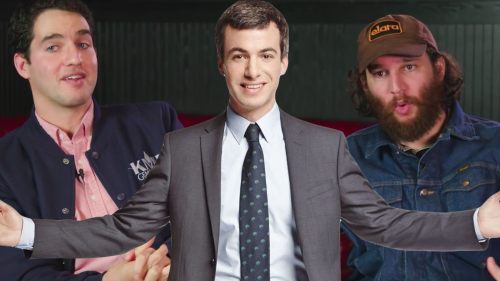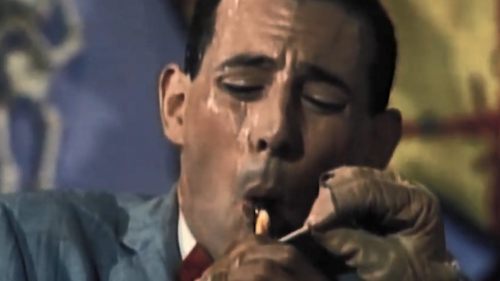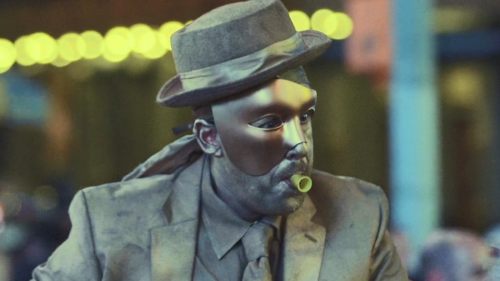WILD-ASS CINEMA WEEK: Ronald Bronstein’s FROWNLAND
All week long, Birth.Movies.Death. is celebrating the arrival of the Safdie Bros.' Uncut Gems with a series of editorials about some of our favorite Wild-Ass movies. Some of these movies have direct connective tissue to the Safdies' previous films, some are completely unrelated except for their wildness, all are absolutely bonkers and, in our opinion, mandatory viewing. Welcome to Wild-Ass Cinema Week. Get your tickets to see Uncut Gems at the Alamo Drafthouse here.
Critics describe characters as being on the precipice of “falling apart” a lot, but Frownland’s Keith presents the rare example in which that assessment appears to be literally, physically true. Dore Mann plays the character with the fidgety energy of a man struggling to hold his body together, as if it’s a failing machine that he must frantically maintain like Charlie Chaplin in the Modern Times factory. He’s never not moving, stuck in a permanent state of switching-off between wiping the perspiration off his brow and fixing his hair and adjusting his clothes and stretching his jaw and gurning his face and hitting himself in the head. He derives all of his power from talking, gasping for air from one sentence to the next because he can’t bear to stop for a single solitary moment. If he stops, he will die. The audience doesn’t know why that might be, but they can nonetheless feel that it is true.
That’s the spiritual link tying Keith to Howard Ratner, the perpetual motion machine at the center of Uncut Gems. They’re half-brothers, sharing a father in Ronald Bronstein, Frownland writer-director and longtime collaborator of Josh and Benny Safdie. He’s the third credited screenwriter on Gems, and the secret weapon responsible for the relentless motormouthed propulsion that many viewers responded to in both that film and its predecessor Good Time. Frownland provides the square one for this lo-fi cinema of anxiety, ramping up everything that would later earn his movies with the Safdies the adjective “abrasive” while eschewing everything that would make them underground hits. If the Safdies joints seem designed to induce panic attacks, the unalloyed Bronstein was intended to push its audience to the brink of a fistfight. As the legend goes, at one screening in Las Vegas, it did.
“He was agitated by it, in the way a molecule is agitated,” said Bronstein of the brawler “violently upset” by his handiwork. It’s an apt analogy, particularly in its focus on energy channeled from the potential to the kinetic. What Frownland could be said to be “about” is a tricky question; in between arguments with his girlfriend and his roommate, both of whom vocally hate him, Keith goes door-to-door pushing questionable coupons allegedly benefitting MS patients. The film’s real focus is tension, not as an element mounting and falling from scene to scene but as a sustained tone unto itself. It is the medium in which the film lives, water to the fish, a fact of life in Bronstein’s sweaty vision of a non-stop New York.
Paul Thomas Anderson knew how to pressurize a scene to unbearable levels: put two characters at opposing purposes, refuse to allow either to cede to the other’s crosstalk, and then throw in a third element to keep everyone off-balance. (Hence Cosmo, throwing the firecrackers.) Bronstein cranks each component part to eleven, tasking Mann with mountains of dialogue that the actor often bungles and starts over as he grows angrier with himself, and the person he’s speaking to, and the world. There’s always something else jutting out of the background, too, whether it’s a constantly barking dog or a whistling teakettle or a third person yelling nonsense. In these scenes, Bronstein leaves no open spaces, nowhere for his captive audience to catch their breath.
Which makes the rare moments between freakouts in which Bronstein does permit a flash of repose all the more disarming. Keith is a visibly miserable man, but the source of his misery remains unclear. (Aside from his shitty life, defined as it is by his pitiable financial and living situations.) His pathologically annoying behavior and his dedication to alienating everyone in his general vicinity both stem from an unease with himself and everything around him. He’s got nowhere to go, which Bronstein drives home with interludes that show Keith messily rushing from one part of town to the next. He’s placeless, and it makes him nervous.
In this respect, he’s of a piece with the odd outlier of a film that contains him. Frownland was a cult object by the purest definition, one supported by a word-of-mouth network made up of those lucky enough to see the 16mm prints that Bronstein personally brought around the festival circuit. With a reputation as fascinating only in the most repellent sense, the film couldn’t lock down a distributor, so he showed it in New York on his own dime to another wave of simpatico spirits mesmerized by all things revolting. It’s now gained a more respectable, institutional home on the Criterion Channel streaming network, but that can’t scrub away all the lustrous grime. For viewers with the required masochistic streak, for anyone hypnotized by an artist’s earnest effort to destabilize his subjects, it will forever live on as something precious found in the gutter.



